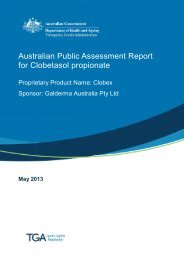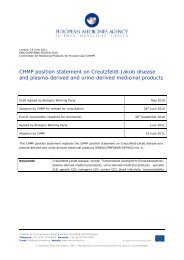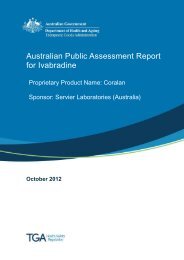Australian public assessment for Ibuprofen - Therapeutic Goods ...
Australian public assessment for Ibuprofen - Therapeutic Goods ...
Australian public assessment for Ibuprofen - Therapeutic Goods ...
You also want an ePaper? Increase the reach of your titles
YUMPU automatically turns print PDFs into web optimized ePapers that Google loves.
AusPAR Caldolor <strong>Ibuprofen</strong> Phebra Pty Ltd PM-2010-02393-3-1<br />
Final 2 January 2013<br />
<strong>Therapeutic</strong> <strong>Goods</strong> Administration<br />
and various <strong>for</strong>ms of pain) should be at least as good as the efficacy of the oral<br />
preparations.<br />
Extrapolation of the safety of Caldolor on PK grounds is more problematic. Firstly, the<br />
proposed maximum daily dose of Caldolor is higher than the dose that is approved in<br />
Australia <strong>for</strong> oral ibuprofen. Secondly, the PK data still leave open the possibility that the<br />
Cmax of Caldolor might be higher than that of <strong>Australian</strong>-registered oral ibuprofen<br />
products, and the risk of some adverse effects could theoretically be related to peak<br />
ibuprofen concentrations and not just AUC. These considerations mean that one cannot<br />
infer the full safety profile of Caldolor on the basis of experience with <strong>Australian</strong>registered<br />
oral ibuprofen products. One might, of course, infer a safety profile on the basis<br />
of experience with US-registered oral ibuprofen products (as reflected in the FDAapproved<br />
PIs <strong>for</strong> those products). This, however, is not usually regarded as an acceptable<br />
approach because the TGA does not have access to the original data and it is tantamount to<br />
accepting a product <strong>for</strong> registration in Australia purely because it has been approved in<br />
the USA.<br />
The FDA noted that there is little experience with the use of oral ibuprofen in critically ill<br />
patients - a clinical situation in which an IV preparation such as Caldolor is likely to be<br />
used. Also, oral ibuprofen preparations are not specifically approved in Australia or the<br />
USA <strong>for</strong> perioperative pain management, another use <strong>for</strong> which Caldolor is likely to be<br />
promoted, given the studies that were conducted by the sponsor. The FDA was unwilling<br />
to rely solely on bioequivalence data and insisted on clinical studies of Caldolor in these<br />
situations, even though the issues mentioned above regarding the comparator in the<br />
bioequivalence studies and the proposed maximum dose were not relevant to the FDA.<br />
Those clinical studies have also been provided to the TGA.<br />
While insufficient to infer that Caldor is safe <strong>for</strong> the proposed indications, the PK data, in<br />
association with the tolerability study CPI-CL-006 (see Dosage Selection in Pivotal Studies<br />
below) are sufficient to justify the choice of doses and the use of a 30 minute infusion in<br />
the pivotal studies. They also showed that Caldolor injection needs to be diluted prior to<br />
infusion to avoid an unacceptable incidence of infusion site pain.<br />
The PK data indicate that the proposed alternative of rapid infusion of Caldolor over 5 to 7<br />
minutes is not acceptable, due to the resultant doubling of Cmax with untested safety<br />
consequences. Rapid infusion was also associated with a high incidence of infusion tie<br />
pain, albeit mild.<br />
The PK findings in CPI-CL-004 indicate that no change to the Caldolor dose interval is<br />
required in critically ill patients. Although the PK data also show that ibuprofen<br />
concentrations are approximately halved in critically ill patients <strong>for</strong> a given dose of<br />
Caldolor, the lack of a positive dose response in critically ill patients and potential safety<br />
concerns (most notably about adverse renal effects in patients with underlying fluid<br />
balance abnormalities and compromised renal perfusion) argue against routinely<br />
increasing the dose of Caldolor in patients who are critically ill.<br />
Pharmacodynamics<br />
The current submission did not include any clinical studies of the pharmacological effects<br />
of ibuprofen but these are well known from studies of oral preparations and need not be<br />
reiterated here.<br />
Dose- or concentration-response relationship<br />
In the current submission, plasma ibuprofen concentrations were measured in a large<br />
majority of patients in the fever study CPI-CL-004 but no <strong>for</strong>mal analysis of the<br />
relationship between ibuprofen plasma concentration and temperature reduction was<br />
Page 22 of 118
















